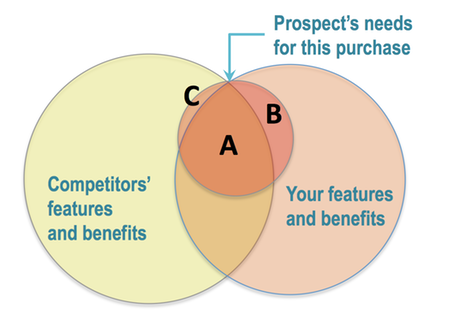Earlier posts stressed the need to develop proposals that address an issuer’s specific requirements and how to build relationships that provide the needed input to proposal strategy, including business development in large prospects.
As a team, that means understanding your prospect’s needs, the ideal solution, and what other bidders are likely to offer to address each key requirement.
The Venn diagram below will help organize that understanding.
How do you, your prospect and competitors intersect?
The small circle (upper centre) represents the prospect’s needs and hot button issues, or “solution wish list.” The medium circle on the right represents the features of your potential solutions. The large circle on the left represents the features available from other offers. You can think of this circle as all competitors, or your closest competitor—whichever makes more sense.

Analyse the overlaps
Looking at the areas where the larger circles overlap with the small circle:
- Segment A includes features both you and your competitors´ offer, and that the prospect needs or wants.
- Segment B contains your features you offer, that the prospect needs or wants—and that competing solutions can´t match. For example, while both you and one or more competitors have the ability to perform, you may be the only proponent with key individuals who successfully completed the exact type of project on bid (same size and scope) in the past year. Since you´ve learned that recent proven success in a similar project is on the prospect´s wish list (in the small circle), it is a differentiator.
- Segment C contains features where at least one other competitor offers features you cannot claim.
NOTE: While you can infer the prospect’s preferences from past experience, some will be less obvious than the recent experience example above. Nothing beats a proposal based on intimate knowledge of the prospect’s needs and issue—which is why pre-RFP discovery is essential.
What actions will you take?
This model prompts two questions:
- Which features—both compliance items and those your sales discovery tells you are important—belong in each of A, B and C?
- Having identified A, B and C items, what actions will you take?
Consult our blog index for posts that help answer these questions.


